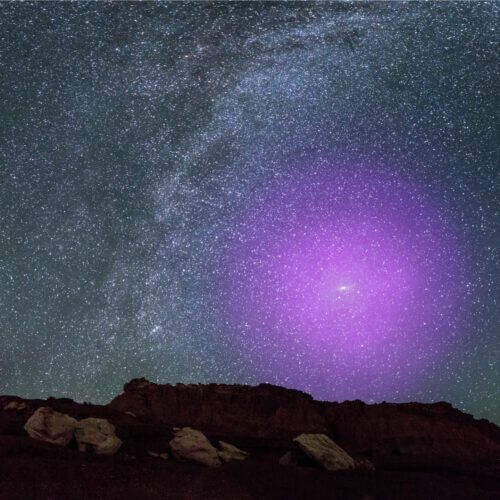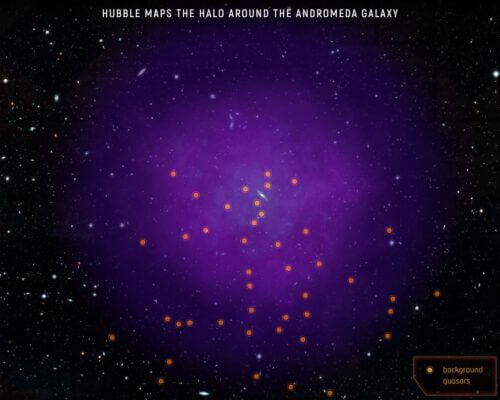"Understanding the nature of the vast halos of gas surrounding galaxies is extremely important," explained co-researcher Samantha Barak of Yale University. "This reservoir of gas will serve as fuel for future star formation within the galaxy. It also absorbs gas remnants from supernova explosions"

In a groundbreaking study, scientists used NASA's Hubble Space Telescope to map the vast envelope of gas, known as a halo, that surrounds the Andromeda Galaxy, our nearest large galactic neighbor. Scientists were surprised to discover that a faint and almost invisible halo of diffuse plasma extends 1.3 million light-years from the galaxy - roughly to the middle of the Milky Way, and up to 2 million light-years in some directions. This means that Andromeda's halo is already bumping into our galaxy's halo. They also found that the halo has a layered structure, with two distinct bursts of gas.
This is the most comprehensive study of a halo around a galaxy.
"Understanding the nature of the vast halos of gas surrounding galaxies is extremely important," explained co-researcher Samantha Barak of Yale University in New Haven, Connecticut. "This reservoir of gas will serve as fuel for future star formation within the galaxy. It also absorbs gas remnants from supernova explosions. The research has revealed clues about the development of the Andromeda Galaxy in the past and what the future of the galaxy will look like, and in addition we are also learning new and fascinating details about our closest neighbor."
"We find that the inner shell of the halo, which extends over half a million light-years, is much more complex and dynamic than we previously thought," explained research director Nicola Lehner from the University of Notre Dame in Indiana. "The outer shell is smoother and warmer. This difference is most likely an effect of supernova activity in the disk of the galaxy that directly affected the inner halo."

The researchers confirmed this after discovering heavy elements in Andromeda's gaseous halo. Heavy elements develop in the cores of stars and are then ejected into space, sometimes violently, when the star dies. The halo is full of this material from such explosions.”
The Andromeda Galaxy, also known as M31, is a spiral galaxy containing about a trillion stars and is similar in size to our Milky Way. Located 2.5 million light-years away, it is so close to us that the galaxy appears as a cigar-shaped patch of light high in the autumn sky. If its gaseous aura could be seen with the naked eye, it would occupy an area of the sky three times wider than the Big Dipper and would be the most prominent object in the night sky.
Using a program called Project AMIGA (Ionized Gas Absorption Map in Andromeda), the study examined the light from 43 quasars - the distant and bright cores of active galaxies with black holes at their center - located far beyond Andromeda. The quasars are scattered behind the halo, allowing scientists to examine several sections of the halo, when observing the quasar's light through it and how this light level changes in different areas.
Andromeda's vast halo is made of a rare, ionized gas that does not emit easily detectable radiation. Therefore tracking the absorption of light originating from the background is a better way to study this material.
The researchers used the unique capability of Hubble's Cosmic Origins Spectrograph (COS) to study the ultraviolet light from the quasars. Ultraviolet light is absorbed by the Earth's atmosphere, preventing viewing with ground-based telescopes. The team used COS to detect ionized gas of carbon, silicon and oxygen. An atom becomes ionized when the radiation strips it of one or more electrons.
In 2015, team members first discovered that a large, massive halo surrounds Andromeda, but there was no hint of its complexity. It is now mapped in greater detail, leading to a more accurate determination of its size and mass.
"In the past there was very little information - when we only used six quasars that are up to a million light years away from us and Andromeda. This new program provides more information about the inner region of Andromeda's halo," explained J. Christopher Hawke, also of Notre Dame and co-author of the paper. "Probing gas in this radius is important, because the halo in this region is affected by the galaxy's gravity."
Because we live inside it, scientists cannot study the signature of the Milky Way's halo easily. However, they believe that the halos of Andromeda and the Milky Way must be very similar because these two galaxies are quite similar. The two galaxies are on a collision course, and they will merge and form a giant elliptical galaxy starting about four billion years from now.
https://www.eurekalert.org/pub_releases/2020-08/nsfc-hmg082720.php
- The violent history of the Andromeda galaxy, which is on its way to collide with the Milky Way
- Are our galaxy and neighboring galaxy Andromeda already touching and will collide sooner than we think?
- Researchers from the Hebrew University have developed a revolutionary model to explain the formation of galaxies

7 תגובות
Regarding the question of how galaxies collide in an expanding universe.
There are groups of galaxies in the universe. Each group moves away from each other but within
The group the galaxies are in rotate and move together in the group and therefore they are
They collide with each other and the big one swallows the small one.
It is likely that the closer a given point within the halo is to the center of the halo/galaxy, the greater the density of the halo there. Given that the halo spreads to a neighboring galaxy, the density of the halo in the fringe regions of the neighboring galaxy is greater than in the regions that spread further into the neighboring galaxy. Thus, the halo increases the radial acceleration of the edge of the neighboring galaxy.
This provides a certain explanation for the observed phenomenon according to which the edge of the galaxy exhibits a higher acceleration than expected given the stellar mass observed there.
Accordingly, it is possible that a reasonable competing explanation to the speculative explanation based on the speculative hypothesis regarding the existence of "dark matter" emerges. More precise measurements of the relevant masses are needed to begin to establish such a competing explanation.
What does 'swallow' 'eat' 'devour' mean? Is there a violent expression of the phenomenon? Does she join the Milky Way or make it join her by 'eliminating' some stars along the way. How can a galaxy similar in size to another galaxy swallow the other galaxy? The various articles discussing Andromeda/Milky Way do not provide a definitive answer and it is impossible to understand the meaning of the words ate/swallowed/devoured/attached, etc. Perhaps one of the site's experts may have a normal answer so that people like us understand what it is about?
gas reservoir? Answer will already sell it to us at an exorbitant price.
How does the theory that the universe is expanding fit with the intended accessibility of the two galaxies?
The true picture of the universe cannot be discovered by observation.
Details in the article
http://img2.timg.co.il/forums/2/7512af65-e1e5-47ac-af36-b3654d2d790b.pdf
We will write in the article:
"A faint, nearly invisible halo of diffuse plasma extends 1.3 million light-years from the galaxy (Andromeda)—about halfway to the Milky Way," end quote.
Should be: up to the middle of the distance between the Milky Way and Andromeda.
Additionally, note that this halo is located where the dark matter around the Andromeda galaxy should be.
Good night
Yehuda